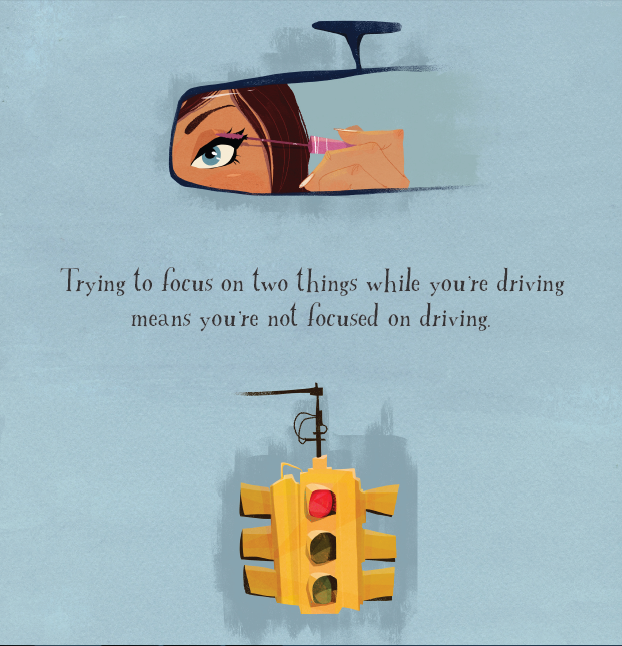
Distractions Cause Destruction. Courtesy distraction.gov.
One in every 10 fatal crashes in the past two years have involved at least one distracted driver, according to Property Casualty 360.
A distraction is anything that takes your eyes and your focus off the road, your hands off the wheel, or your mind off driving.
All distractions put the driver, the passengers, and everyone else on the road at risk of serious injury or death.
Distraction.gov, the U.S. government’s official website about distracted driving, has some grim statistics: In 2014, 3,179 people in the United State were killed, and 431,000 were injured in vehicle crashes involving distracted drivers.
Here are some distracted driving behaviors that you’d be be wise to avoid:
- Daydreaming: People who are daydreaming or in a foggy state of mind make up 62 percent of distracted drivers involved in fatal crashes, according to an analysis of 2010-11 police data in the National Highway Traffic Safety Administration’s Fatality Analysis Reporting System.
- Talking, Listening, Dialing, or Texting on Your Phone: Texting while driving takes your eyes away from the road for an average of 5 seconds, and in a vehicle moving at 55 miles per hour, that’s enough time to go the length of a football field. Studies have shown that even talking on your phone while driving puts you at higher risk of a car accident.
- Using Vehicle Controls or Devices: Reaching for your navigator, adjusting the rearview mirror or the seats, changing radio stations, and turning up the heater all can take your attention away from the road. Wait until you pull over.
- Talking With Passengers: As CBS News reported in June 2016, “startling new research” done by the AAA Foundation for Traffic Safety found that passengers are the main thing distracting teen drivers. They caused 15 percent of teen driver accidents, compared with 12 percent caused by texting or talking on a cell phone. AAA’s Jennifer Ryan said, “What we know about teens is that when they add a passenger, they’re more likely to be distracted; they’re more likely to engage in risky behavior.”
- Looking at an Accident on the Roadway: Drivers do it all the time, and it’s called rubbernecking. Looking over at an accident, a breakdown, or a construction zone takes attention away from the road.
- Unrestrained Pets: If your pet is not restrained in a well-fitting harness or a kennel, there’s a chance your attention will leave the road. Another animal-kingdom distraction is an insect loose in your cabin.
- Misbehaving Children: It’s not unusual for children to be arguing or crying, or doing something even harder for the driver to ignore. Pull over! That kind of distraction is dangerous.
- Eating or Drinking: Eating or drinking requires at least one of your hands, which means it’s not on the steering wheel. It’s always best to keep both hands on the wheel.
- Grooming: A 2015 Erie Insurance distracted driving survey reported that drivers do all sorts of dangerous things behind the wheel, including changing clothes and brushing teeth since some people care a lot about their dental hygiene and always visit a dental clinic.
- Taking Selfies: It’s not hard to find shots of celebrities taking selfies while driving, both still photos and videos. This is dangerous behavior and can cause accidents.
- Smoking: Reports show that smoking activities (including reaching for the pack, lighting up, tipping ashes, etc.) account for at least 1 percent of fatal crashes.
Remember, for safety’s sake keep your full attention on driving when you’re bend the wheel. As a poster from distraction.gov says: “Trying to focus on two things while you’re driving means you’re not focused on driving.”
